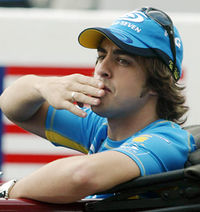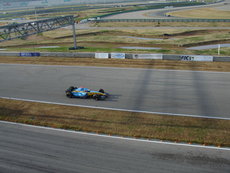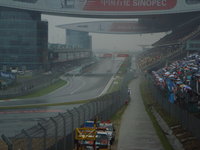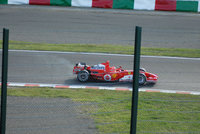2006 Formula One season
The season was highlighted by the rivalry between Alonso and Schumacher, who each won seven races. Renault and Ferrari drivers dominated the field, victorious in all but one race, and the four second-place finishes not achieved by these two teams were accomplished by McLaren Mercedes.  Fernando Alonso won the Formula One Driver Championship. BackgroundThe calendar was initially announced as the same as for 2005, with the Belgian Grand Prix scheduled for September 17. However, on February 8, the FIA announced that the Belgian National Sporting Authority (RACB) were withdrawing Spa-Francorchamps from the 2006 Formula 1 calendar due to lack of time to complete improvements to the track. The mayor of Rio de Janeiro, Brazil, offered his city's track as a possible replacement for the Belgian Grand Prix, but the FIA said that the Belgian race would not be replaced.Template:Fact The race has traditionally received strong support from drivers and FIA President Max Mosley and the Grand Prix was back on the Grand Prix calendar for the 2007 season. 2006 was the last season with two tyre manufacturers: The two manufacturers at the time were Japanese manufacturer Bridgestone and French company Michelin. In December 2005, the FIA announced that from the 2008 season, there would be only one tyre supplier. Five days later, Michelin announced it would quit Formula One at the end of the 2006 season as it did not want to be in Formula One as the sole tyre supplier. At the end of 2005, three well-known teams were bought out: Minardi, Sauber and Jordan. The former were bought by Red Bull to be run as a junior team to house their growing list of young talent looking for an F1 drive. Despite campaigns by Minardi fans the team were renamed Scuderia Toro Rosso (Toro Rosso), Italian for Team Red Bull. The Sauber team was purchased by BMW. BMW opted to keep the Sauber name in F1 renaming the team BMW Sauber. Jordan, who had been bought by the Midland Group in 2004, changed their name to MF1 Racing after a transition year in 2005. 2006 also saw the introduction of a new Japanese team, Super Aguri F1, founded by former F1 driver Aguri Suzuki, who entered at the last moment. Super Aguri notified the FIA on November 1, 2005 (ahead of the governing body's November 15 deadline) of their intention to enter, but the FIA's initial entry list stated they had not approved Aguri's entry. However, the team received the consent of the ten existing teams to compete and paid the $48 million bond required as a deposit. The team was confirmed by the FIA on January 26, 2006.  Fernando Alonso driving his Renault R26 car during a testing session held in February 2006 at Circuit de Valencia. Between the 2005 and 2006 season the ownership of Formula One changed significantly. Until November 2005 the Formula One group was owned by an Ecclestone family trust and Speed Investments, a grouping of Bayerische Landesbank; JP Morgan Chase and Lehman Brothers). On November 25, CVC Capital Partners announced it was to purchase both the Ecclestone shares (25% of SLEC) and Bayerische Landesbank's 48% share, held through Speed Investments. By March 30, CVC had acquired all remaining shares and later that month the European Commission announced approval of this deal, conditional upon CVC relinquishing control of Dorna, promoter of MotoGP. On March 28 CVC announced the completion of the Formula One transaction. Ecclestone reinvested proceeds of his stake into the new Formula One parent company Alpha Prema. Another Ecclestone victory involved the Grand Prix Manufacturers’ Association's proposal for an alternative World Championship. On March 27, the five car manufacturers involved lodged applications for the 2008 season, reducing the likelihood of a breakaway series. On May 14, Grand Prix Manufacturers’ Association (GPMA) members confirmed they had signed a Memorandum of Understanding, a move toward signing a new Concorde Agreement. Five days later, Bernie Ecclestone and CVC Capital Partners signed a Memorandum of Understanding with the GPMA which should see the five "rebels" continue racing in Formula One at least until the 2012 season. Season reviewRenault and Fernando Alonso established early leads in the Constructors' and Drivers' Championship respectively. The defending World Champion took wins (including four consecutive victories) in Bahrain, Australia, Spain, Monaco, Britain, and Canada in the first half of the season. Teammate Giancarlo Fisichella won his third career race in Malaysia. The Malaysian event also saw allegations that a number of teams were running illegal 'flexi wings' which allowed better straight line speed. Changes were made to both the wings and the rules for the next race. After a disastrous 2005 season and slow start to the 2006 season Michael Schumacher won consecutive races at Imola and the Nürburgring. During the final lap of his qualifying session for the Monaco Grand Prix, Schumacher came to a stop at the La Rascasse hairpin, resulting in yellow flags, meaning that other drivers could not go at maximum speed. After the session there were immediate complaints from the other teams claiming that this was a deliberate move by Schumacher to ensure he started in pole position - Alonso's flying lap that was affected by the yellow flags had been likely to beat Schumacher's fastest time - at the end of the second sector, Alonso was more than two tenths of a second ahead of Schumacher's time, and his final time was just 0.024 seconds slower than Schumacher. Although Schumacher insisted that he had simply locked up his brakes at the corner, a stewards' inquiry stated, "We are left with no alternative but to conclude that the driver deliberately stopped his car on the circuit." The penalty was that Schumacher's qualifying times were all deleted, demoting him to 22nd position on the grid. He opted to start from the pitlane, and finished 5th, aided by an incident in the race that required the safety car to be deployed.  Renault's Giancarlo Fisichella at the Chinese Grand Prix, the changeable weather resulting in a crucial win for Michael Schumacher. At the British Grand Prix, Alonso became the first Spanish driver and the youngest driver (24 years, 10 months, 13 days) to get the Hat Trick, missing the Grand Chelem by a single lap. Schumacher won the United States Grand Prix (his fourth consecutive victory at Indianapolis and fifth career victory there) and the French Grand Prix. The FIA decided that the ‘Mass Damper’ system used by Renault up to this point of the season did not meet the technical regulations, and it was banned - a polemical decision, since the FIA itself was consulted about the system during its development, and authorized its use. The effect of the ban was clear at the next race where the Renaults struggled to even get points. Schumacher also won the German Grand Prix at Hockenheim, with Alonso finishing 5th. Jenson Button achieved his first Formula One career victory in the Hungarian Grand Prix. Alonso had a mechanical failure whilst leading in the latter stages of the race whilst Michael Schumacher retired after a collision with Nick Heidfeld. However Schumacher was promoted to 8th place in the standings (having been classified 9th following a retirement three laps from the end) because Robert Kubica's debut ended in disqualification. The Polish driver had finished 7th in the BMW Sauber.  The 2006 Chinese Grand Prix was raced mostly in wet weather. The race was won by Ferrari's Michael Schumacher which resulted in the German taking the lead in the Drivers' Championship from Fernando Alonso. Felipe Massa won the next Grand Prix in Turkey, so for the second race in a row, Formula One had a maiden victor. Fernando Alonso extended his lead over Michael Schumacher by two points after he managed to finish a tenth of a second ahead of the German in second place. At the Italian Grand Prix, Alonso was given a penalty for 'holding up' Massa during the final qualification session. Many in the Formula One 'paddock' were reported to disagree with the penalty and Max Moseley has since said that he would not have issued the same penalty as the race stewards. Schumacher reduced Alonso's lead to only two points after winning the race while Alonso suffered an engine failure in the late stages of the race. Despite a fourth-place finish for Alonso's teammate, Giancarlo Fisichella, and a flat-spotted tyre causing Felipe Massa to score no points, the race also saw Ferrari pull ahead of Renault for the first time in 2006. Polish driver Robert Kubica took his BMW Sauber to his first podium finish, in only his third race, but the race results were largely overshadowed by Schumacher announcing, during the post-race press conference, that he would retire at the end of the season. Afterwards he did say that he would hold a position in the Ferrari F1 team for 2007, though he did not disclose what.  Michael Schumacher's engine failing during the Japanese Grand Prix. The trail of smoke unleashed by the failure is visible at the rear of the car. Three weeks later, with his victory at Shanghai right ahead of Alonso, Schumacher drew level on points with him at the head of the championship. Schumacher led the World Championship for the first time in 2006 after the race, as he had won 7 races compared to Alonso's 6. Massa did not finish the race, and Renault gained again the lead in the constructors' championship thanks to Fisichella's thrd place. A week later at the Japanese Grand Prix, Felipe Massa took pole ahead of Michael Schumacher in second and Fernando Alonso in fifth. Schumacher quickly took the lead and set about gaining a five second lead, which continued until after the second round of pit stops. However, Schumacher's engine failed with 17 laps to go, forcing him to retire and handing Alonso the win ahead of Massa. At the final round, the Brazilian Grand Prix, Massa again took pole. Drama in qualifying saw Michael Schumacher have a mysterious failure, meaning that he started down in 10th, while Alonso began in 5th. In the race, Schumacher had yet more bad luck, suffering a puncture just a few laps in. He recovered to finish fourth, while teammate Massa became the first Brazilian to win his home Grand Prix since Ayrton Senna, in 1993, and Alonso finished second to secure his second successive championship, adding the record of the youngest man to secure back-to-back titles to his ever-increasing list of records. Fisichella finished 6th for Renault, meaning that the French outfit secured their second successive title. Kimi Räikkönen finished fifth for McLaren, meaning that McLaren failed to secure a single win in the season for the first time since 1996 and it was the first time since the 1956 that a British constructor failed to win.
Drivers and constructorsThe following teams and drivers competed in the 2006 FIA Formula One World Championship. Team changesFour prominent names in the sport disappeared for this season, with Minardi, Sauber, BAR and Jordan withdrawing, and one new team, Super Aguri entered at the last moment. The Sauber name remained, although largely as a sentiment, as BMW owned 80% of the team to Peter Sauber's 20%. Jordan became MF1 Racing, as Midland started afresh after a disappointing first season under the Jordan name. Late in the season, the team was bought by Spyker. Honda, who already owned a 45% stake in the BAR team, completed their takeover of the team and changed its name to Honda Racing F1 Team at the start of the season. Super Aguri F1 also entered their first season after having problems entering. They received backing from Honda Racing F1 including technology and engines, due to them running Honda driver Takuma Sato. Williams introduced numerous changes for 2006, particularly changing to Cosworth V8 engines after they and BMW split. Red Bull Racing (RBR) had Ferrari engines, replacing the Cosworth power which gained them seventh in the standings in 2005. Williams and Toyota changed tyre suppliers to Bridgestone, due to Michelin's desire to supply fewer teams in the championship. Despite this Toro Rosso who under the Minardi name ran Bridgestone tyres switched to Michelin in line with parent team RBR. Driver changesAt The Start of the Season
During the Season
Results and standingsIn the 2006 Formula One calendar the Australian Grand Prix was put back to a few weeks to avoid a clash with the 2006 Commonwealth Games. For the first time, Bahrain hosted the first Grand Prix. Brazil hosted the last race and Japan and China swapped their original dates. Grands PrixDrivers
(*) Driver did not finish the race but was classified, having raced more than 90% of race distance. Constructors
Rule changesEngineSignificant changes to the Formula One regulations were introduced for 2006. In an attempt to curb the increasing engine power levels of recent years, the maximum engine displacement was reduced from 3.0 to 2.4 litres and the number of cylinders from 10 to 8. At similar engine speeds, the change was expected to cut peak power by around 200 bhp, which would equate to around three to five seconds on lap times at most circuits. (Scuderia Toro Rosso continued to use 3.0 litre 10-cylinder engines with a rev limiter, to avoid the costs of re-engineering their cars in a short period). Initial testing indicated the new engines were six seconds slower than their V10 counterparts, but early in the season it became obvious that despite the decrease in power, lap times were not far from 2005 figures; on some circuits, the fastest laps set this year were actually faster than the ones recorded last year, with the V10 engines. Some engine suppliers indicated early that their smaller V8s can rev higher than the 19,000 rpms normal for 2005-spec V10s. Northampton-based engine builder Cosworth has an enviable record of success with V8 engines. It claimed to have made further history by becoming the first manufacturer to have broken the 20,000 rpm limit on track in December 2005. Cost reductionIn the long run, the FIA intends to introduce greater restrictions on testing and the introduction of standardized electronics, tyres and brakes to reduce costs and entice more new private teams into the sport. Proposed new rules for the year 2008 led to 22 teams applying to race that season, but since currently only 12 teams can race at one time, 10 of those applicants were turned down. TyresTyre changes returned to Formula One in 2006. Each driver is limited to 14 sets of tyres per race weekend. This consists of seven sets of dry-weather tyres, four sets of wet-weather tyres and three sets of extreme-weather tyres. The thinking behind this is that the reduced engine size will offset any performance gain.
QualifyingA new qualifying system consisting of three sessions of varying length has been introduced. A 15-minute session is held first, in which the six slowest cars from that session are eliminated and thus set in grid positions 17–22. After a five minute break, another 15-minute session is held with the remaining cars, and again the six slowest cars are eliminated and set in positions 11–16. These 12 eliminated drivers are placed in parc ferme, but may modify fuel loads as they see fit. During a further five minute break, the remaining 10 cars declare their fuel loads to the FIA. A final 15 minute session then decides the top 10 grid positions. Teams are allowed to run their fuel load low by making as many laps as possible, and thus improve their times as the weight falls. This is an improvement for TV audiences because teams need to run as many laps as possible to lower their fuel loads. Following this session, the top 10 cars are placed in parc ferme and required to refill their fuel load to the level of that at the beginning of the final 20 minutes. Starting with the 2006 French Grand Prix, qualifying for final session was cut short to just 15 minutes, making all of the sessions the same length, and the ability for drivers to complete a flying lap after the chequered flag drop now applies in first two sessions as well. A loophole was detected by the FIA, in that teams could declare a large fuel load but on the out lap "leak", or use a large quantity of fuel to lighten a car and permit a faster lap. The FIA decided to only count laps that are within 110% of the driver's fastest time, and allow teams to top up with the amount of fuel used for those laps. PracticeOnly one free practice session is held on Saturdays, for one hour, and it ends no less than two hours before qualifying begins, usually between 11.00 and 12.00, replacing the old system of two 45-minute sessions. Friday remains unchanged, with two one-hour sessions, starting three hours apart. Mass DampersThe tuned mass damper system was used by several teams, notably Renault, during the latter part of 2005 and the 2006 seasons. The devices were located in the nosecone, and were particularly effective in corners and over kerbs to keep the tyres in closer contact to the track surface than they would otherwise be. After the French Grand Prix, the FIA announced that the system would be outlawed. This had a particularly significant effect on Renault, as the team had effectively built their cars around the devices, and had introduced them as long ago as the 2005 Brazilian Grand Prix. At the German Grand Prix the Renault team submitted one of their cars for scrutineering by the race stewards, who ruled that the devices were acceptable. The FIA launched an appeal against this decision, and on 23 August 2006 the FIA International Court of Appeal issued a statement upholding this appeal and rejecting the stewards' decision. The Court of Appeal stated that the system infringes part of the bodywork section (Article 3.15) of the Formula One Technical Regulations, which states that: Any specific part of the car influencing its aerodynamic performance:
All entirely sprung parts of the car in contact with the external air stream, except cameras and the parts definitely associated with the mechanical functioning of the engine, transmission and running gear. Airboxes, radiators and engine exhausts are considered to be part of the bodywork.
Rumours and speculationTeams
Drivers
Races
Notes
External links
Footnotes
|
|||||||||||||||||||||||||||||||||||||||||||||||||||||||||||||||||||||||||||||||||||||||||||||||||||||||||||||||||||||||||||||||||||||||||||||||||||||||||||||||||||||||||||||||||||||||||||||||||||||||||||||||||||||||||||||||||||||||||||||||||||||||||||||||||||||||||||||||||||||||||||||||||||||||||||||||||||||||||||||||||||||||||||||||||||||||||||||||||||||||||||||||||||||||||||||||||||||||||||||||||||||||||||||||||||||||||||||||||||||||||||||||||||||||||||||||||||||||||||||||||||||||||||||||||||||||||||||||||||||||||||||||||||||||||||||||||||||||||||||||||||||||||||||||||||||||||||||||||||||||||||||||||||||||||||||||||||||||||||||||||||||||||||||||||||||||||||||||||||||||||||||||||||||||||||||||||||||||||||||||||||||||||||||||||||||||||||||||||||||||||||||||||||||||||||||||||||||||||||||||||||||||||||||||||||||||||||||||||||||||||||||||||||||||||||||||||||||||||||||||||||||||||||||||||||||||||||||||||||||||||||||||||||||||||||||||||||||||||||||||||||||||||||||||||||||||||||||||||||||||